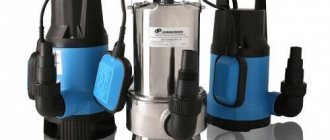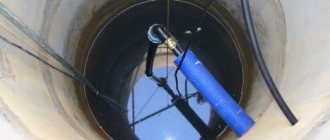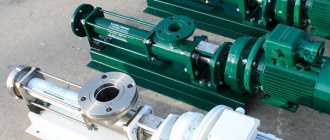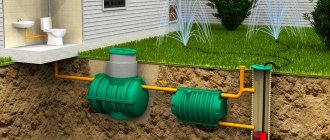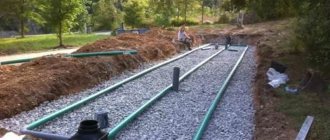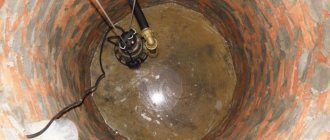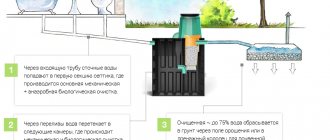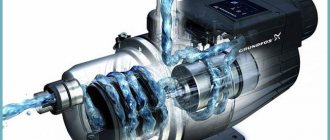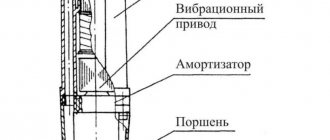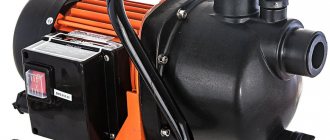Many owners of private houses, as well as residents of apartment buildings, have repeatedly encountered the fact that after heavy rainfall, the water supply system broke through, or a large amount of water accumulated.
Excess moisture begins to destroy the foundation and spoils the walls. Mold and mildew may appear. Plaster is crumbling and building materials are collapsing.
To minimize the consequences of floods, a good solution would be to install a drainage pump. In addition to basements, they are used in the organization of wells, swimming pools, etc.
What is a drain pump
First you need to understand what this submersible drainage pump is and how it works.
This is a device designed to pump out large amounts of water. The device can be used for different purposes and tasks. But there is a nuance that limits the scope of application. This is the amount of impurities in water. The recommended value is no more than 10% of impurities from the total volume of water. If this requirement is not met, then the unit will quickly fail.
At the same time, there is a special drainage system pump designed to work specifically with dirty water. Both devices operate on the same principle. But there is a difference between them.
A conventional drainage pump works with particles no larger than 12 mm in diameter. And devices focused on pumping and pumping out dirty water can also work with impurities up to 120 mm in diameter. There are special knives installed inside that cut debris and feces into small particles, which avoids clogging the hoses.
At the same time, so-called fecal pumps equipped with knives can effectively pump absolutely clean water without impurities and debris.
The device is capable of raising water to a certain height. This value is small, since the device cannot create high pressure.
Selecting and installing a pump in a well, video
In special cases, in order to maintain the purity of the water, the pump must be left at the bottom of the well. In this case, once a year it is necessary to lift the pump and clean its filter from contaminants. The practice has become widespread when a well is cleared of blockages once every few years. On average, cleaning takes several days, after which the pump is stored indoors.
When purchasing a drainage pump, it is recommended to focus not only on the technical characteristics, but also on the maintainability of the device. You need to find out whether components for it are on sale, find out the location of the nearest service center. It should also be remembered that models from well-known companies are more reliable and durable.
Types of devices
Knowing how a drainage pump with a float switch works and is designed, as well as other types of devices, it will be easier to understand the essence of working with it, the features of application, connection and maintenance.
Devices are divided into submersible and surface.
Submersible
The most popular drainage pump is the submersible type. It has a fairly simple connection diagram. Although sometimes, to connect the device, you have to contact specialists.
During operation, submersible pumps are in water. Even underneath it. They are used to lift liquids to a considerable height, which is achieved with good power. The main advantages of submersible units are their compact size and quiet operation. They can be immersed to a depth of about 50 meters.
But the device is not without its drawbacks. Submersible units are difficult to repair. Opening the case is quite a problem. To fix the breakdown, you first need to pull the pump out of the water, which takes a lot of effort and time. Sometimes only masters can cope with such a task.
In terms of the principle of operation, a submersible pump is in many ways similar to an external pump. But there is a difference. The submersible unit independently absorbs water. And in outdoor ones this is done using hoses.
To suck up liquid, there are holes at the bottom of the submersible pump. And behind them there are mesh-type filters. This allows you to protect the unit from large debris, stones, etc. getting inside.
Most often, the circuit includes a float, and connecting such a drainage pump is not particularly difficult. But there are also devices without a float, surface ones.
The advantage of the submersible type is that it does not need to be turned on. The device comes into operation automatically, responding to changes in the position of the float. The latter monitors the water level.
Submersible pumps are further divided into vertical and horizontal. In the first case, the maximum immersion depth is 7 meters. And horizontal ones can go 100 meters or more deep.
Ease of use lies in the fact that there is no need for a cooling system. The pump is in the water, plus it pumps liquid through itself. This allows you not only to get the job done, but also to remove excess heat.
The submersible pump has a subtype. It's called semi-submersible. The difference is that the working mechanism is immersed in water, but the engine remains on the surface. But a semi-submersible pump cannot cope with water containing large debris.
Surface
The second type is superficial. They are used to organize the operation of a well or borehole. The device body is not immersed in a liquid environment.
Water comes from a long connected hose. This pump is used in situations where the water is located at shallow depths. The most common area of use is groundwater control.
It is believed that the main advantage of the unit is ease of installation and removal. Periodic maintenance is also easy. But it is important that the working elements are lubricated on time. This will increase service life and prevent breakdowns.
But the device also has its drawbacks:
- inferior in functionality to a submersible pump;
- consumes a lot of energy;
- liquid cannot be pumped out at great depths;
- heats up quickly;
- makes noise during operation;
- shorter service life.
Although it is worth noting that in terms of energy consumption, a submersible and surface drainage pump can be equated.
Recommendations for choosing equipment
Submersible pumps are made with a housing made of plastic or metal. The first option is damaged more quickly by the passage of solid particles, so its service life is relatively short. On the other hand, it is better to choose surface samples with less weight to simplify the transportation of equipment. There is also a lower level of noise emitted during operation.
Model of a submersible pump with a metal casing Source ngorod60.ru
Important criteria for choosing a drainage pump are the fraction of impurities and power. The latter determines the maximum depth of the water source. These parameters are different for all models. Submersible type samples are considered optimal, as they work better throughout the year.
Regarding productivity for the private sector, experts often focus on 180-200 liters per minute. The pressure or force of pushing the liquid out is directly reflected in the length of the connected hoses. As a rule, for every meter submerged in water there is 10 m of horizontal channel.
Design features
Now let's figure out how the drainage pump works and what its main structural elements are. You already know that units for collecting dirty water (sewage pumps) are distinguished by the presence of a kind of auger.
If we talk about the general principle of the drainage pump design, then it is worth highlighting the following design elements.
- Electric motor. The main working element of the drainage pump. Its power directly affects how much liquid the unit can handle per unit of time. The electric motor starts working when connected to the mains. Or it can be put into operation using a fuel generator.
- Shaft with impeller. Comes into operation simultaneously with the electric motor. The liquid enters the pump and exits through the hoses. The movement of water is facilitated by a rotating shaft with an impeller, the operation of which is based on the principles of centrifugal force.
- Float. An important element that ensures that the unit is turned on and off automatically. Although it is possible to find a pump without a float, it is better not to use them. In the absence of a float, you will have to monitor the pumping of liquid independently and constantly. And if the pump completely goes under water, or the reservoir runs out of liquid for pumping, this will lead to pump failure.
- Filters. They protect the pump from large debris, stones, and various impurities. Mesh filters are usually used. The size of the cells in the filters determines how large impurities the pump can pass through without harming the device.
- Hoses and shredders. The shredder chops up large debris. This system is mainly used on fecal drainage pumps. Hoses are needed to redirect the liquid sucked into the pump.
When choosing a sump pump, be sure to study the technical specifications and also take a look at the maximum allowable size and the amount of contaminants that this model can handle.
Some pumps are focused on the purest water possible, and therefore are mainly used in swimming pools.
The next important point is the water temperature. Sometimes sump pumps can handle hot liquids. This leads to overheating of the motor if the pump was not originally designed to operate in such conditions.
Therefore, in technical documents, the manufacturer always indicates what the temperature limit of a particular model is. Some units are specially designed to pump water and other liquids with temperatures of 50 degrees Celsius and above.
Installation in a well and connection
To install a drainage pump in a well yourself, you must follow a certain sequence of actions and safety rules. Units for wells cannot be used for installation in a well, since although they have a similar appearance, such models have completely different operating features and permissible power. If a well pump was installed in the well, it will simply burn out after some time. It is also not recommended to use cheap models with questionable build quality.
Installing a drainage pump in a well
A very important parameter when choosing submersible pumps is the diameter of the well or casing. It is necessary to select a pump whose diameter is at least a few millimeters smaller. It is worth paying attention to the fact that the diameter of the pumps is specified in inches, and the diameter of the pipes in millimeters.
Models for immersion in a well are distinguished by their ease of installation and operation, but for high-quality and uninterrupted operation it is necessary to adhere to the following rules:
- Using connecting elements , it is necessary to secure the pressure line;
- If the pump is equipped with a float switch , then a pressure line is installed.
- If the pump has a three-phase electric motor , it is necessary to monitor the phase connections. The device turns on, after which you need to determine the direction in which the shaft rotates. If the rotation occurs clockwise, then the device is connected correctly.
- If rotation occurs counterclockwise , you need to disconnect the pump from the electrical network, and then change the order of connecting the phases;
- Equipment must be mounted in a vertical position.
- The pressure pipe must be directed upward. After this, the pump should be lowered to the bottom of the structure.
Scheme of permanent installation of a drainage pump
How drainage pumps beat their competitors
How it works
Now to the question of how drainage pumps for dirty water and conventional units of this type work.
Due to the operation of the engine, impeller and hose system, water is taken from one place and transferred to another. These could be treatment facilities, special tanks, or simply an open plot of land.
But the float switch or just a float deserves special attention. We need to talk about how it works in a drainage pump.
Structurally, the float consists of:
- plastic case with air inside;
- switch with a lever (also known as a breaker);
- steel ball;
- wires for connection to the electrical system.
By immersing the pump in water with a large volume of liquid, the float floats up, appears on the surface and thereby turns on the unit. He reads that there is a lot of water. As the level of water being pumped decreases, the float also decreases. If it falls below the minimum permissible level, an automatic shutdown occurs.
When rising or falling, the steel ball of the float changes its position, due to which it controls the lever. It affects the switch and its contacts. The switch can break the circuit or connect it.
Advantages over competitors
When compared to other pumps, drainage devices have a number of important advantages. Namely:
- relatively low price;
- large volumes of pumped liquid;
- good generated pressure;
- simplicity and ease of operation (more relevant to surface pumps);
- solid service life.
Depending on the maximum pressure that a particular drainage pump creates during operation, in 1 hour of operation some models are capable of pumping up to 8 cubic meters of water. The pressure reaches 7 meters. As a result, in a short period of time you can replace the water in your entire home pool.
What material is used to make devices
Often, modern models of float drainage pumps are made from cast iron and stainless steel in combination with other materials that will be needed to assemble the device body and other necessary parts. They are subject to a fairly simple comparison:
- stainless steel. A fairly reliable and time-tested material with a service life of decades;
- cast iron. The strength of a device made from this material will be amazing, but its weight will be enormous, and the cost will be quite high;
- plastic. It is the cheapest material, the durability of which is low.
Equipment whose body is made of plastic, while the wheel itself is made of steel, is in considerable demand. It is excellent and the best value for money. Relatively recently, several models of these units entered the market, the working blades of which are made of technical polymer. They are cheaper than their high-tech counterparts. They are characterized by durability, strength and practicality.
Household use
Many people are rightly interested in how to properly use a household drainage pump.
The big advantage of the drainage unit is that its design is quite simple. Therefore, anyone who does not have experience or special knowledge can master the principles of operation.
If you don't know how to properly use a drainage water pump, refer to the following principles.
- Connect the pipe to the outlet. The submersible pump has one. The external type of drainage pumps additionally have a suction hose. Fastening is usually achieved with clamps. This eliminates the formation of leaks during operation. Pipes are selected by diameter based on the characteristics of the pump. Usually the manufacturer prescribes these points in the instructions and operating manual. This relates to the question of what hose will be needed to operate the drainage pump.
- Immerse the pump in the liquid medium. It’s just not worth putting it on the bottom. Typically, stands are used, or the unit is suspended above the bottom. This prevents clogging of the inlet openings. With surface drainages everything is simpler. Only the inlet pipe and float, which are held on the cable, are immersed in water. In general, installing a drainage pump in water is not difficult. But it is important to do this correctly so that the entrance holes do not stand on the ground. Otherwise, instead of water, the device will begin to suck in dirt, sand and other debris. The filters will not last long and will soon become clogged.
- Start the system. Pumping out water using a submersible pump is as simple as possible. The only requirement is to periodically check the condition of the filters. They must not be allowed to clog. For external systems, suction is started through a pipe. Moreover, it is important to first start the system and then send the pipe into the liquid.
Maintaining a sump water pump is quite simple. Usually the user only needs to clean the filter and check the condition of the pipes and hoses.
There are no particular difficulties with how to correctly and competently use the considered drainage pump.
Hose selection
Separately, you should consider the optimal diameter of the hose that will be needed to connect the drainage pump. Plus, some of its other characteristics also play a role.
The following recommendations can be given in this regard.
- Diameter. Directly affects the length. It is considered one of the key parameters for the effective operation of a drainage pump. Most often, hoses with a diameter of 32, 40 and 50 mm are installed on such pumps. But the smaller the diameter, the higher the likelihood of clogging. Therefore, in sewer systems where a drainage pump is used, it is recommended to use larger diameter pipes.
- Length. Here they are guided by the following principle: one meter of depth in terms of the required power corresponds to 10 meters in the horizontal plane. For example, if the depth of the pit from which the liquid is pumped is 5 meters, then the length of the hose is chosen to be 50 meters. But here the pumping speed will be small, since the length of the outlet along the ground must additionally be taken into account. Therefore, a reserve of about 3 meters is usually added to the calculated indicators.
- Temperature resistance. Often drainage units have to work at different times of the year. Therefore, the hose should not lose elasticity or deform during temperature changes.
- Material of manufacture. The optimal solution would be a vinyl or PVC hose. The material is the most resistant to various influencing factors.
Knowing all these points, you can choose the right components, assemble the pump unit and count on long-term and trouble-free operation.
Design features and principle of operation
Thanks to the drainage pump device, you can automate and easily get rid of problems such as:
Removing excess water after heavy rainfall, after rising groundwater levels (from a basement, construction site), or flooding.- Pumping dirty water from a pond, silted well, pit or sewer.
- Irrigation of soil in greenhouses or small plots.
- Pumping water from container to container.
Almost every country house needs this pump, but all problems will not be solved just by purchasing it. Remember that you must also know the operating principle and device. This will make it possible not only to choose the right pump that will be suitable for specific tasks, but also to use it correctly.
Rules for operating the pump when cleaning a well
It is important not to make a mistake when choosing a pump for pumping water from a well. Units with different characteristics are hidden under the name drainage. Some are intended only for clean water; if you try to remove silt from the well with them, breakage cannot be avoided. The apparatus used must be able to handle pumping water containing mechanical inclusions and fibers. Data on the purpose and capabilities of the pump are specified in the instructions for it.
The power of the unit is selected depending on the frequency of flushing the well. If this is done frequently, for prevention, a low-power device is suitable. To clean a silted well, it is advisable to use a high-power unit.
Heavily contaminated mines are cleaned manually before pumping out water . To do this, a person goes down a ladder into the shaft and scrapes sediment from the walls. This will help to clean the well with the pump faster, its working parts will become less clogged.
The cleaning procedure is simple:
- the apparatus is lowered into the well to a depth at which its intake hole does not reach the bottom 0.5-1.0 m;
- turn on the device and begin cleaning;
- regularly turn off, lift up, clean the filter of the unit;
- after 2 hours of work, take a break for 15 minutes.
Make sure that there is no constant switching on and off. This happens when water flow is low. Then the pump overheats and stops.
Electrical diagrams of water pumps
rice. 1
Consider the electrical circuit in Fig. 1 of the water pump:
The phase wire is connected through a thermal relay to the common terminal of the two stator windings. The neutral wire, as shown in the diagram, has a branch and is further connected to the working and starting stator windings.
The ground wire is connected to the metal body of the water pump.
What are the possible problems with a water pump? The reasons why the water pump may not work are as follows:
- Break in the cable wiring in a certain area;
- relay malfunction;
- capacitor malfunction;
- burnout of the stator windings of the electric motor;
- break in the cable wiring in connection with the plug;
- lack of contact with one of the stator windings
and other reasons.
How to determine such causes of malfunction? It is impossible to visually find the reason here. As with all household appliances, diagnostics are carried out with a device - a multimeter, which has the following functions to determine:
- capacitor capacity;
- presence of resistance in the stator windings;
- checking the cable from the plug to connecting the cable wires to the electric motor.
If the stator windings of the pump electric motor burn out, the stator with windings can be replaced with a new one, or this can be eliminated on your own, that is, rewind the stator. With such rewinding, both the cross-section of the copper wire and the number of turns are taken into account.
Replacement of a burnt-out capacitor is carried out taking into account its corresponding capacitance and the rated voltage value for which the capacitor is designed.
Eliminating possible other causes will not pose any difficulties for you.
Let's consider the following type of water pump "Aquarius" BTsPE 0.5-32 and, accordingly, the electrical circuit for this type of pump, Fig. 2.
This example shows a submersible type of water pump designed for water supply from wells. The circuit in Fig. 2 generally differs from the first circuit in that there are two capacitors connected in series. The network cable is connected through a detachable connection to the water pump circuit. The capacitor box is made in a sealed manner. The stator, as usual, consists of two windings (working and starting). The water pump housing is connected to protective ground.
Modern pump models are equipped with a float switch.
The presented figure clearly shows that when the water level is low, the float switch opens the contacts of the supply line; when the water level is sufficient, the pump will be in the on mode.
The pump is immersed in a container of water on a steel cable. The convenience of this type of pump is that you can fill all kinds of containers with water, both for filling for drinking water, for watering a plot of land and other needs.
Connecting a well pump without auxiliary equipment
Without a control unit, automation unit or other auxiliary equipment, the pump's power supply cable is connected to a pre-installed electrical outlet with a grounding contact.
Grounding of a borehole (submersible) pump is mandatory. To directly connect the grounding, the GZSh (main grounding bus) of the house is used, which in turn is connected to the existing grounding loop of the house.
An electrical cable with a grounding conductor is used to supply power to the pump socket. The supply voltage of the submersible pump is 220 volts.
To power the pump, you need to select a separate electrical group and protect this group with a circuit breaker. The rating of the circuit breaker is calculated based on the electrical power of the pump. So for pumps up to 3,000 W you need a 10 Ampere circuit breaker, for pumps of higher power you will need a 16 Ampere circuit breaker.
Important! This connection cannot be considered correct. It only shows the general principle of connecting a well pump. The lack of automation in controlling the operation of the pump will lead to its malfunctions when water disappears (dry running) in the supply system.
Malfunctions and ways to eliminate them
There are a number of opportunities to repair the equipment yourself, provided that the broken part can be replaced with a new one or a simple technical procedure can be performed (for example, cleaning). To do this, you will have to disassemble the case, perform diagnostics, identify the problem and select an identical part.
If you rarely use drainage equipment or plan to use it only in the event of an accident (flooding), then do not rush to buy an expensive pump - a cheap model is much easier to replace. Pumps Caliber – from 2500 rubles
Available actions include replacing the capacitor, impeller or float, repairing the electrical cable, fixing the shock absorber, and removing large pieces of clay and sand stuck inside the housing.
If the cast iron body is cracked, the valve has failed, or the winding has stopped functioning, you should contact a service center or think about buying a new pump. Inexpensive drainage devices made in China are inexpensive, so it is not advisable to order serious professional repairs.
Failure #1 – the power cord is faulty
The flexible element - the cable - is always at risk, since due to regular twists and kinks (which often happens during transportation and reinstallation of equipment), the wires under the layer of plastic or rubberized protection are torn, resulting in the power supply to the pump being cut off.
It is necessary to find the break point and make a connection. This operation is easy to carry out if the break occurs near the plug - you just need to clean and connect the wires, finally carefully insulating the work area.
When removing the cable, try to mark and remember the attachment points of each wire (they are of different colors) so that during reinstallation you do not confuse “phase”, “ground”, “zero”
A cable break in the pump connection area requires more time to repair. First, you need to remove the equipment from the water, wipe and dry it, then disassemble it to get to the internal connection unit. Get ready for the fact that instead of hexagonal holes you will encounter triple ones, which will make it difficult to select a screwdriver.
The cover should be removed carefully, without jerking or effort. By unscrewing the bolts holding the tension element, you can examine the cable and determine the area of \u200b\u200bthe break. We remove the worn piece, mount the cable in its original place, attach the tension element, and fix the bolts.
Failure #2 – water supply stopped
The engine is running properly, but the fluid has either stopped flowing altogether or is flowing in small uneven jerks.
There may be several reasons for this strange phenomenon:
- Part of the supply line is clogged. This is an outlet pipe or supply pipe. A kind of blockage arose from tufts of algae and pieces of clay. It is necessary to disconnect the pipes and clean them. It is possible that the pipe length is longer than recommended by the manufacturer, and therefore there is not enough pressure to deliver the required power.
- The impeller is worn out. Blades are bent or damaged. You should disassemble the device, replace parts, first visually (as far as possible) determining the cause of the malfunction.
- The fluid is oversaturated with dirt and debris. Therefore, the water has a thick consistency and is difficult to pump. We solve the problem by raising the suction hole a certain distance from the bottom, where sediment accumulates.
- Engine power has noticeably decreased. What can be determined even by sound. There may be problems with the electrical supply, failure of bearings, or depressurization of the oil compartment. It is necessary to disassemble the case to determine the cause of the breakdown and replace worn parts.
The most common problem is a clogged filter. To clean the screen and suction port, you can try running some clean water through the pump. If this procedure does not help, you should disassemble the housing and clean all chambers, removing pebbles, algae and wood chips.
When disassembling, you may encounter an unpleasant “surprise” - the fusion of rusted mounting bolts with the body. The bolt heads must be carefully cut off with a grinder, and new screws must be installed in place of the old fasteners.
When disassembling the unit, be sure to use the manufacturer's diagrams or instructions. They will help you remove parts sequentially and quickly find the bolt attachment points. In some cases, worn fasteners or loose nuts cause parts to become misaligned, which also affects the performance of the machine.
Failure #3 – the engine does not start
You connect the power supply - but the pump does not work, does not make noise and does not pump water. Be prepared to have to examine all the equipment.
Here are the most common causes of engine failure:
- Power supply interruption due to broken wires. We check the cable by touch and find the break point. If the emergency area is in the area of connection to the pump, we act as described above.
- The stator winding has failed. Happens due to dry operation. If you cannot replace it yourself, contact a specialist.
- The bearing is jammed . We check the part for suitability and clean or replace it based on the diagnostic results.
- The suction device is clogged with debris. We clean the blades and grille, check the integrity of the operating elements and the mesh.
- The float switch is broken. To check its functionality, you need to close the relay. The problem may be in the wire connecting the float to the pump.
If the capacitor fails, replacement is required. Some models provide special access to it, which is a separate hole in the case.
If blockages occur quite often, re-read the instructions for the product to clarify the size of the fractions. Perhaps the pump is not designed for pumping liquid with large particles of debris - only a fecal pump is suitable for grinding
Failure #4 – the pump turns off on its own
When the pump is turned on, it starts to work, but after some time it stops spontaneously. Most likely, the protective mechanism is triggered due to engine overheating.
The cause may be a heating cable. It is worth checking the compliance of the mains voltage and the parameters specified by the manufacturer. If the data does not match, you need to purchase a stabilizer.
The cause of overheating or spontaneous shutdown may be oxidation of wires that need to be cut or replaced. The problem becomes obvious after a complete check of the remaining pump parts
Shutdowns can also occur due to the blades being clogged with debris. In this case, we recommend performing a full cleaning procedure, that is, opening the housing, cleaning the internal chambers and impeller, and checking the filter.
If blockages occur quite often, re-read the instructions for the product to clarify the size of the fractions. Perhaps the pump is not designed for pumping liquid with large particles of debris - only a fecal pump is suitable for grinding
Failure #5 – turning on the pump knocks out the electrics
When the pump is turned on, plugs fly out or wires burn out. The reason should be sought in the parts directly responsible for conducting electricity - the cable or stator winding. The serviceability of the wires can be checked using a tester; if a worn section is detected, the entire cable should be replaced or (if the break is near the end) shortened.
Winding repair is a labor-intensive task and requires special knowledge. Even with a carefully installed secondary winding, a short circuit cannot be ruled out. If you don’t have time to tinker with a burnt-out part, take the device to a service center - perhaps, after diagnostics, they will advise you to buy a new pump.
If you decide to repair the winding yourself, try to take into account all the parameters - from the number of turns to the thickness and type of wire
Float switch in action
Before connecting a newly purchased float switch to a pump, it is advisable to ensure that their technical characteristics are compatible. An elementary way to set up the operation of a switch for electric pumps is inside a water tank.
Serial connection diagram for float switch:
- A special sinker (from the kit) is attached to the float cable.
- The cable is securely fixed at the edge of the tank.
- The amplitude of the free movement of the float switch is adjusted to set the highest and lowest levels at which the float switch will operate.
- The float switch is connected to the pump last.
If there is a danger of the float freezing or impeding its free movement in the container, the connection cannot be made.
The main functions performed by a float switch:
- The float connected to the pump that performs the task of filling the tank will turn off when ascending and connect when it reaches the bottom mark.
- For an automatic station: switching on when the upper liquid level mark is reached and switching off at the lower mark (reaching the bottom of the container).
- Valves or valves with a servo drive: the switch will give a signal to close when it is in the upper position (full capacity) and will open the way for water when it reaches the lower position.
- Control room: monitoring of excess and shortage of water.
